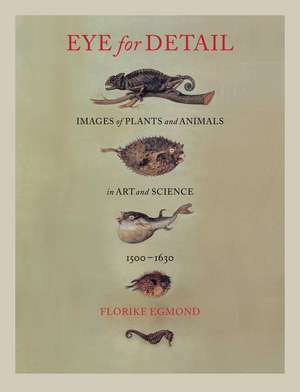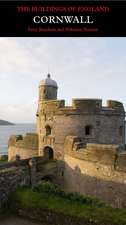Eye for Detail: Images of Plants and Animals in Art and Science, 1500-1630
Autor Florike Egmonden Limba Engleză Hardback – 11 feb 2017
Image-transforming techniques such as close-up, time lapse, and layering are generally associated with the age of photography, but as Florike Egmond shows in this book, they were already being used half a millennium ago. Exploring the world of natural history drawings from the Renaissance, Eye for Detail shows how the function of identification led to image manipulation techniques that will look uncannily familiar to the modern viewer.
Egmond shows how the format of images in nature studies changed dramatically during the Renaissance period, as high-definition naturalistic representation became the rule during a robust output of plant and animal drawings. She examines what visual techniques like magnification can tell us about how early modern Europeans studied and ordered living nature, and she focuses on how attention to visual detail was motivated by an overriding question: the secret of the origins of life. Beautifully and precisely illustrated throughout, this volume serves as an arresting guide to the massive European collections of nature drawings and an absorbing study of natural history art of the sixteenth century.
Egmond shows how the format of images in nature studies changed dramatically during the Renaissance period, as high-definition naturalistic representation became the rule during a robust output of plant and animal drawings. She examines what visual techniques like magnification can tell us about how early modern Europeans studied and ordered living nature, and she focuses on how attention to visual detail was motivated by an overriding question: the secret of the origins of life. Beautifully and precisely illustrated throughout, this volume serves as an arresting guide to the massive European collections of nature drawings and an absorbing study of natural history art of the sixteenth century.
Preț: 311.40 lei
Preț vechi: 356.41 lei
-13% Nou
Puncte Express: 467
Preț estimativ în valută:
59.59€ • 61.99$ • 49.20£
59.59€ • 61.99$ • 49.20£
Carte disponibilă
Livrare economică 25 martie-01 aprilie
Livrare express 08-14 martie pentru 104.03 lei
Preluare comenzi: 021 569.72.76
Specificații
ISBN-13: 9781780236407
ISBN-10: 1780236409
Pagini: 288
Ilustrații: 100 color plates, 25 halftones
Dimensiuni: 191 x 248 x 28 mm
Greutate: 1.14 kg
Editura: REAKTION BOOKS
Colecția Reaktion Books
ISBN-10: 1780236409
Pagini: 288
Ilustrații: 100 color plates, 25 halftones
Dimensiuni: 191 x 248 x 28 mm
Greutate: 1.14 kg
Editura: REAKTION BOOKS
Colecția Reaktion Books
Notă biografică
Florike Egmond is a cultural historian and researcher at the University of Leiden. She lives in Rome.
Cuprins
Introduction
Part I
Nature Captured
1 Green Fashion: Painted Naturalia in Collections
2 Organizing Nature: Painted Albums as Collections
3 In and Out of Order
Part II
Untrue to Life
4 Persuasive High Definition
5 Rendering for Recognition
6 Zoom: Relevant Detail in the Visual Study of Nature
Part III
Micro before the Microscope
7 Minute Observation
8 Visual Dissection
Conclusion
Biographical Notes
Abbreviations and Appendix
References
Select Bibliography
Acknowledgements
List of Illustrations
Index
Part I
Nature Captured
1 Green Fashion: Painted Naturalia in Collections
2 Organizing Nature: Painted Albums as Collections
3 In and Out of Order
Part II
Untrue to Life
4 Persuasive High Definition
5 Rendering for Recognition
6 Zoom: Relevant Detail in the Visual Study of Nature
Part III
Micro before the Microscope
7 Minute Observation
8 Visual Dissection
Conclusion
Biographical Notes
Abbreviations and Appendix
References
Select Bibliography
Acknowledgements
List of Illustrations
Index
Recenzii
"Just where did the uncanny realism of living Nature in early modern European art come from? This is the question Egmond sets out to answer in this engaging book. . . . Egmond illustrates her case using works in which formal beauty and scientific purpose are delightfully combined. The result is a persuasive and enchanting book."
“This is truly a gorgeous book, with a well-written narrative and numerous, well-selected illustrations. Several of the illustrations, drawings, and paintings will be familiar to readers, but most will not. Egmond researched many collections, some of which have never appeared in print. . . . It is fortunate that so much of the material presented here has survived. Recommended.”
“This beautifully produced and densely illustrated book is an important addition to the existing literature on illustrations of nature in the sixteenth and early seventeenth century. . . . A must-read for anyone interested in early modern practitioners of science and the way in which they used their images to communicate their findings.”
“In this important, scholarly, and visually delightful volume, Egmond presents a strikingly original overview of the burgeoning years of natural history depiction. More than mere illustrations to complement texts (as in later printed works), these early drawings formed visual components of collections in which a sense of nature itself was first constructed and given order: it was the drawings themselves that were assembled to form archives that allowed early naturalists to begin to evolve a coherent view of the natural world—what Linnaeus would later describe as the ‘ordering of the natural universe.’ In compiling these graphic representations of natural specimens their authors displayed much more than their individual merits in art-historical terms: they also reveal the genesis of a visual vocabulary for representation that would remain influential for centuries to come. The volume’s title forms an apt metaphor for Egmond's forensic treatment of these images from an era when art and science intersected on equal terms to formulate a world view hitherto beyond conception: her lucid text allows all of us to appreciate the quietly revolutionary advances in understanding brought about by these innovatory observers of nature.”








